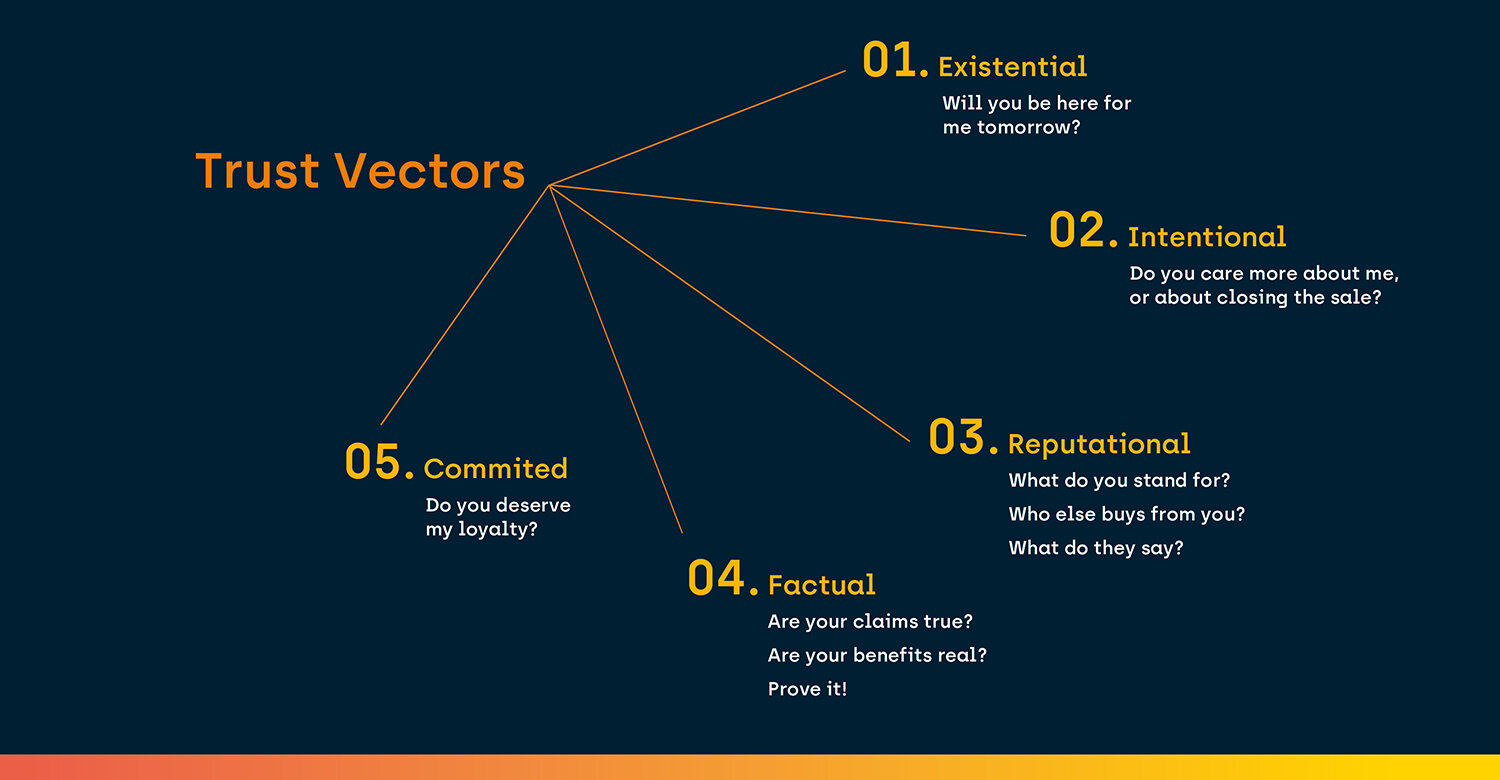Existential trust: How are you REALLY doing?
Building Existential Trust Requires Heroic Transparency.
In the early months of the pandemic, we became aware that the generalized anxiety the world was experiencing was having negative effects on businesses, across all sectors and industries. Fear of scarcity, of COVID, of climate change, of joblessness, had stalled forward momentum. It became clear that as fear and anxiety grew—as we watched businesses close doors, reduce staff, slow down processes, etc.—that trust in brands was waning, and sales were falling.
We realized that if we didn’t address the elephant in the room—lack of trust—all of our tried-and-true marketing growth strategies would be hamstrung. So we set out to crystalize the vectors that define brand trust.
How does your brand measure up?
The five vectors (in orange) and their associated fears (in white) span the customer journey, from the time a prospect considers its first purchase from you to whether they stay (as a long-term customer) or stray (to a more trustworthy brand).
Existential Trust: Will you be here for me tomorrow?
We call the first vector “Existential Trust,” because it affects our perception of the seller’s current and continued viability, financial health, and long-term customer commitment. If there’s any hint that the company may be struggling, any doubt that if the customer is dissatisfied with their purchase they will get the refund or the help they need, prospects will move on and buy from a company that has done a better, more transparent job of expressing its strength and its commitment to customer satisfaction.
Today’s consumers are digging deeper and learning more before they buy. Not just about your product and competitors, but about who you are as a brand. And they become skittish if they sense weakness or see that you’re struggling,
Communicate with transparency
You may be asking, “But what if we ARE struggling to survive?” Don’t we owe it to our shareholders to try and cover up our true situation and close as many sales as possible before? Actually, you owe it to your customers to deliver reliable, consistent value, while doing your best to meet shareholder expectations. There are honorable, profitable ways to do both.
Tell the truth. It is possible for a struggling company to build trust under these circumstances.
Determine the trade-offs you must make to ensure your own viability, and identify customer priorities that you can meet, within your choices.
Communicate clearly what you can deliver to your customers.
Give advanced warning if promises cannot be fulfilled.
You may be hesitant to reveal your current weaknesses to the world, but, as always, the hits to your brand’s reputation if you overpromise and underdeliver can be far worse. Furthermore, your transparency will create the benefit of the doubt. Customers will appreciate that you’re doing everything you can under the circumstances and be less harsh in their judgements.
Be human: highlight your story and your people to attract and keep business
You don’t project an image of solidity and longevity with stock images of tall buildings and bustling offices. Or with business jargon and fancy graphics. Questions arise, “Are they not showing actual employees because they’re a small garage-startup with a fancy website.” Or, “Do they have such a high turnover that they can’t be bothered updating their leaders’ headshots?” Or, “Do they have enough staff to actually deliver on their promises?”
The truth is, your company is your people, so tell the story of their contribution to your company’s success. Tell their unique stories of resilience and grit during the pandemic, and how they all came back together to serve customers. Feature long-term employees, name names, and show photos. Use quotes by employees about their commitment to customer satisfaction. And extend the human elements beyond your About page, into other marketing communications, wherever possible.
People want to know how your company rallied and persevered since the pandemic. Did you quickly regroup and adjust to virtual operations? How did you implement extraordinary efforts to care for customers and preserve the integrity of your brand’s benefits?
Give your brand a face customers can relate to, because leaving a monolithic corporate entity is much easier than leaving a team of dedicated professionals who have worked hard to earn their loyalty.
Win hearts and minds, and close sales
Customers who feel cared for will be more forgiving, more trusting, and more willing to buy from you. If you fail to meet customer expectations, apologize, offer a good-faith compensation for the inconvenience, and reassure customers truthfully.
Make promises you can keep and take responsibility for your agreements.
Increase the cadence of your communications, with updates on positive progress.
Step up community involvement with frequent social media and blog postings.
Listen carefully and respond to individual customer concerns quickly, before bad reviews are written.
Reinforce that you are a company of caring employees who are doing all they can to keep customers happy.
Remove roadblocks to communication. Make it easier than ever to phone, email, chat, and resolve issues quickly and efficiently.
Replace your website’s tired old testimonials with new, fresh ones, and post new case histories to showcase your current wins.
Strengthen cybersecurity to make customers feel safe doing business with you.
This is article #1 in our trust vector series. Watch for in-depth posts about the other four vectors in the weeks ahead. To measure your company’s trust score on all five, take the free Infinite Edge Trust Assessment right now. It takes about eight minutes and generates immediate feedback you can use right away.
InfiniteEdge is a consultancy of marketing and culture experts that helps companies build trust and navigate today’s rapidly evolving market environment, while providing all the marketing services you'd expect from a top-tier integrated agency. Invite us in to help you transition your marketing operation from reactive to responsive and develop a roadmap to help you thrive through the coming unknown.



